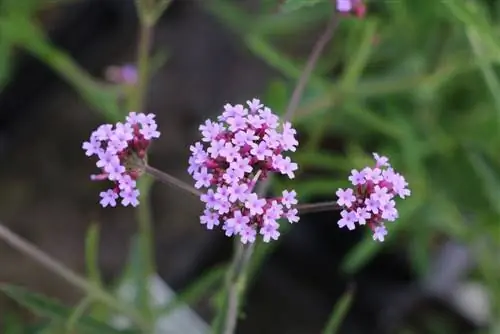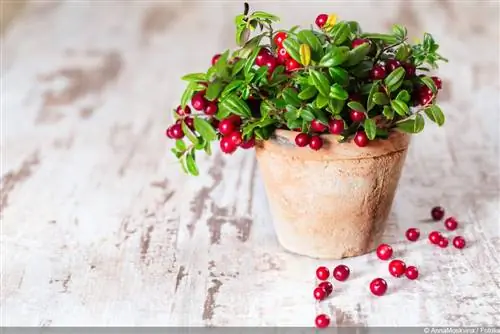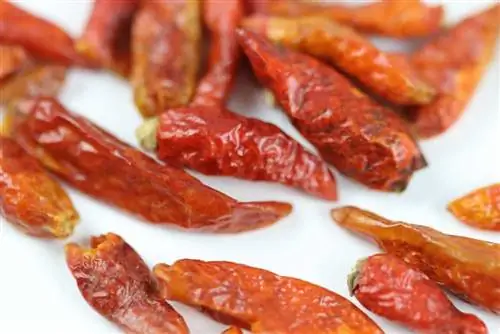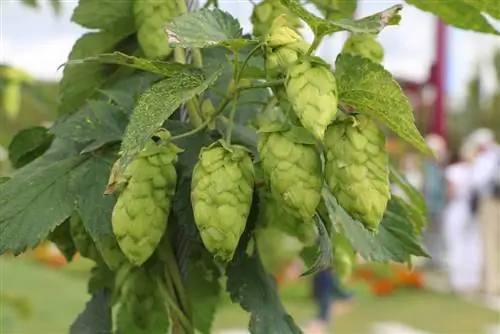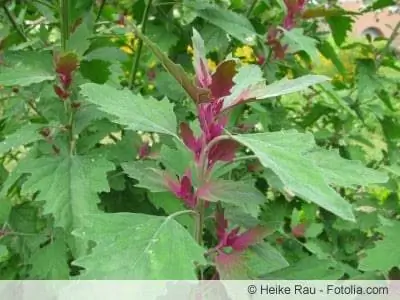- Author admin [email protected].
- Public 2023-12-17 03:39.
- Last modified 2025-01-24 12:45.
Vervain has the botanical name Verbena officinalis and has been used as a medicinal herb since ancient times. The plant is popularly known by many other names, including cat's blood, legend, pigeon and wish herb. Because of its long-lasting abundance of flowers, verbena has become very popular in home gardens. This has certain requirements in terms of both care and site conditions in order to thrive.
Location & plant substrate
Vervain originally comes from South America and is therefore used to a lot of sun. Due to its resistant and persistent properties, the plant can adapt well, but the right location conditions are crucial for a rich and long-lasting flowering period. Verbenas have established themselves primarily as garden plants, but due to the large variety of varieties, they are also very common on balconies and terraces. There are both tall and low growing varieties, some of which climb upwards. That's why these are very suitable as hanging plants for outdoor use.
- Prefers full sun to sunny locations
- Grows poorly in partial shade, then produces weak flowers
- Locations protected from the wind are ideal
- Suitable for both garden beds and pots and containers
- Satisfies normal and well-drained garden soils
- However, nutrient-rich and humus-rich soils are better
- Slightly calcareous to neutral soil qualities are possible
- A slightly acidic soil pH value is optimal
- Fill the planter with conventional potting soil
Sowing & Planting
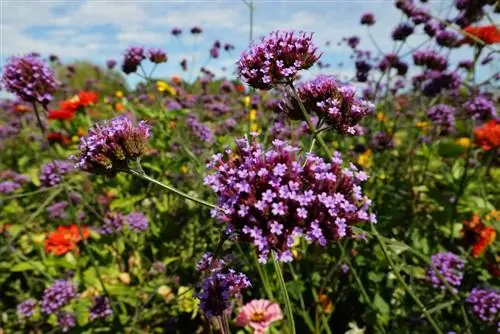
Since verbena does not tolerate frosty temperatures, it should only be planted in the garden bed after the Ice Saints. If there is a risk of waterlogging at the desired location, then it is advisable to create a drainage system. In order to guarantee good soil moisture right from the start, the root ball should be placed in a container with water while it is still in the pot so that it can soak up well. This makes it much easier for verbena to plant in its new location. If the soil is poor in nutrients, soil improvement is also necessary. During the planting process, press the substrate well from time to time so that the verbena gets a good hold. When planting, a suitable distance from other garden plants is very important, although the verbena can be planted in larger groups as a unit.
- Plant in the garden from mid-May at the earliest
- Either through previous sowing or as finished plants
- Remove weeds, large stones and old roots at the intended planting site
- Thoroughly loosen the soil with a garden rake
- Dig up a planting hole twice the size of the root ball
- Enrich the excavation, horn shavings and horn meal are ideal
- Then create drainage made of fine-grained material
- Gravel or broken pottery shards are suitable for this
- Carefully remove verbena from the pot
- Pull the roots apart very slightly with both hands
- Good planting distance is between 30-40 cm
- 2-3 copies are possible for hanging baskets
Tip:
Extremely nutrient-poor soils should be enriched before planting and sowing; this can be done by spreading garden compost, manure or complete fertilizer.
Watering & Fertilizing
Sufficient nutrients in the soil are very important for good growth and long-lasting flowering. However, in a nutrient-rich garden bed, additional fertilizer is usually not necessary. Verbenas also rely on well-moist soil, but can also survive short-term dry periods. Potted plants in particular need sufficient watering, but no water should remain in the container or saucer. If they are hanging specimens, then they tolerate excess moisture much better. These varieties can even survive heavy downpours.
- Water regularly but not excessively
- Avoid waterlogging at all costs
- Higher water requirements when kept in containers
- Do a thumb test before watering
- Only water again when the upper layer of soil is dry
- For nutrient-poor soil, fertilize monthly
- Organic complete fertilizer with mineral elements is ideal
- Provide potted plants with liquid fertilizer every 2 weeks
Cutting

Basically, verbena does not need any shaping pruning, but this helps to maintain the he althy appearance of the plants for longer. However, it is advisable to periodically remove wilted plant parts to prevent signs of rot. In this way, new flowers form in the same place after a few weeks and the verbena flowering period lasts longer.
- Cut off wilted inflorescences regularly
- Clean out old and dried leaves every now and then
- Detip young plants after sowing
- As a result, the plants grow bushier
- Cut back in autumn before overwintering
Wintering
Vervain comes from sunny climes, which is why the ornamental plant does not survive the frost temperatures particularly well in the local latitudes. This is why it is only treated as an annual garden plant, especially in higher and exposed locations. For this reason, many hobby gardeners remove the verbena from the garden in autumn at the latest in order to plant new, young plants in the ground again next spring. However, with the right measures, verbena can also be overwintered in your own garden so that it can display its floral splendor again for a second or even third year. It is also possible to overwinter outdoors when kept in a container, but the plant then needs additional protection against frost, especially from below.
- Very sensitive to cold, cannot survive temperatures below zero
- Cut the plant close to the ground after flowering in autumn
- Cover with a thick layer of large leaves, straw or brushwood
- Move planters to bright and frost-free rooms
- Alternatively, a protected area outside is possible
- Wrap the container with warming foil
- Place on wooden or Styrofoam block
- Give a small dose of water every now and then
- Stop fertilizer application completely in winter
Tip:
During the wintering phase, the verbena must not be watered too much, as excessive watering can cause signs of rot. However, the plants must not dry out completely, as this will cause them to die.
Propagate
Verbenas normally multiply by themselves in a suitable location in the garden. If you want to carry out this propagation on your own, you must note that the verbena family is a cold germinator. Their seeds need a cold stimulus in order to germinate. After the flowering period, the typical hermit fruits form in the mint family. These burst open during the fall season and distribute an abundance of fresh seeds throughout the garden area.
- Spread seeds on damp and absorbent paper
- Additionally cover with foil, then store at room temperature for about 2-4 weeks
- Then roll up and store in the fridge for 4-6 weeks
- Temperature values between 0° to -4° C are good
- Seeds must not dry out completely during the cold period
- Wet lightly every now and then
- Advance in February or March
- Take seeds out of the fridge and cover them discreetly with soil
- These germinate at around 20 °C
- Seedlings appear after 2-3 weeks
- Plant out in the garden bed from May
Harvest & Use
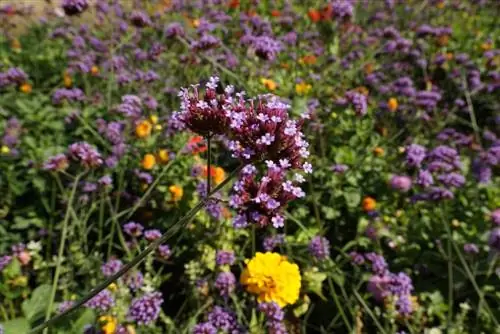
In the verbena family, not every variety can be used in the same way as a medicinal plant. Most of the specimens in stores are only annual ornamental plants that have no healing properties and are only used for appearance. However, the perennial vervain can be used as a medicinal plant and provides relief for many he alth problems. During the drying process, it is important to ensure that there are no signs of rot. Rotten plant parts can no longer be consumed and should be removed.
- Consumed mainly in the form of tea
- Harvest only lush green leaves without aphids
- Afterwards let it dry thoroughly
- Relieves heartburn and diarrhea
- Also helps with colds, bronchitis and catarrh
- Relieves urinary tract diseases and wounds
- Helps dissolve kidney and gallstones
- Supports the treatment of anemia, jaundice and nervous disorders
- Stimulates appetite
Diseases & Pests
Basically, verbena is a very resilient plant that can defend itself well against diseases and pests. However, care errors, incorrect location conditions and temperatures that are too frosty weaken their immune system, which can lead to an infestation or illness-related problems. If there has been a large-scale infestation with fungal diseases, then the entire plant should be disposed of with household waste.
- Susceptible to powdery mildew
- Aphids and snails like the plants
- Wash off lice with soapy water
- Put out slug pellets
- Many problems can be avoided with optimal care

